10.1.3.2: Dividing Whole Numbers and Applications
( \newcommand{\kernel}{\mathrm{null}\,}\)
- Use three different ways to represent division.
- Divide whole numbers.
- Perform long division.
- Divide whole numbers by a power of 10.
- Recognize that division by 0 is not defined.
- Solve application problems using division.
Introduction
Some people think about division as “fair sharing” because when you divide a number you are trying to create equal parts. Division is also the inverse operation of multiplication because it “undoes” multiplication. In multiplication, you combine equal sets to create a total. In division, you separate a whole group into sets that have the same amount. For example, you could use division to determine how to share 40 empanadas among 12 guests at a party.
What is Division?
Division is splitting into equal parts or groups. For example, one might use division to determine how to share a plate of cookies evenly among a group. If there are 15 cookies to be shared among five people, you could divide 15 by 5 to find the “fair share” that each person would get. Consider the picture below.
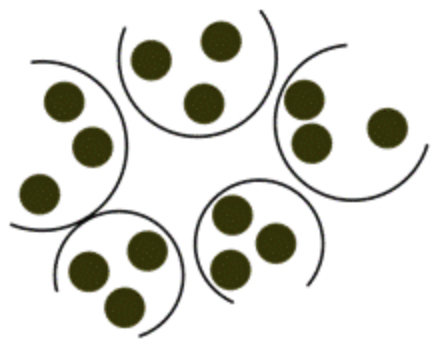
15 cookies split evenly across 5 plates results in 3 cookies on each plate. You could represent this situation with the equation:
15÷5=3
You could also use a number line to model this division. Just as you can think of multiplication as repeated addition, you can think of division as repeated subtraction. Consider how many jumps you take by 5s as you move from 15 back to 0 on the number line.

Notice that there are 3 jumps that you make when you skip count by 5 from 15 back to 0 on the number line. This is like subtracting 5 from 15 three times. This repeated subtraction can be represented by the equation: 15÷5=3.
Finally, consider how an area model can show this division. Ask yourself, if you were to make a rectangle that contained 15 squares with 5 squares in a row, how many rows would there be in the rectangle? Start by making one row of 5 squares:
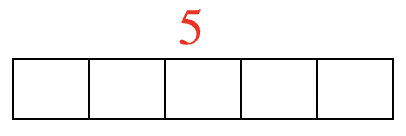
Then add two more rows of 5 squares so you have 15 squares.
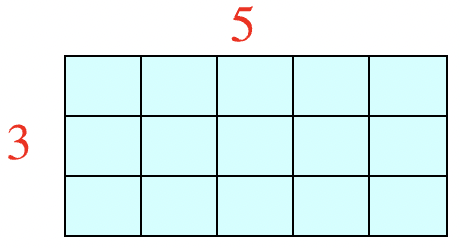
The number of rows is 3. So, 15 divided by 5 is equal to 3.
Find 24÷3 using a set model and a number line model.
Solution
Set Model:
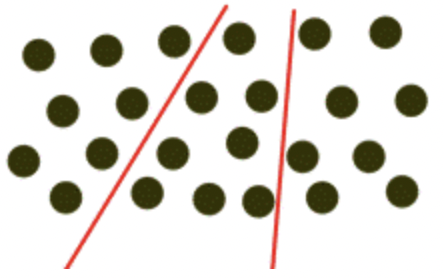
Number line model:

24÷3=8
Ways to Represent Division
As with multiplication, division can be written using a few different symbols. We showed this division written as 15÷5=3, but it can also be written two other ways:
35\longdiv15
155=3
Each part of a division problem has a name. The number that is being divided up, that is the total, is called the dividend. In the work in this topic, this number will be the larger number, but that is not always true in mathematics. The number that is dividing the dividend is called the divisor. The answer to a division problem is called the quotient.
The blue box below summarizes the terminology and common ways to represent division.
12÷3=4 (with a division symbol; this equation is read "12 divided by 3 equals 4."
43\longdiv12 (with a division or long division symbol; this expression is read "12 divided by 3 equals 4." Notice here, though, that you have to start with what is underneath the symbol. This may take some getting used to since you are reading from right to left and bottom to top!)
123=4 (with a fraction bar; this expression can also be read "12 divided by 3 equals 4." In this format, you read from top to bottom.)
In the examples above, 12 is the dividend, 3 is the divisor and 4 is the quotient.
Dividend ÷ Divisor = Quotient
QuotientDivisor\longdivDividend
Dividend Divisor = Quotient
Which of the following expressions represent dividing $56 equally among 7 people?
#1: 756
#2: 56÷7
#3: 56\longdiv7
- #2 represents the situation.
- All three expressions represent the situation.
- #1 represents the situation.
- #3 represents the situation.
- Answer
-
- Correct. #2 is the only expression that represents 56 divided by 7.
- Incorrect. #1 and #3 represent 7 divided by 56, not 56 divided by 7. The correct answer is #2 is the only expression that represents the situation.
- Incorrect. This expression represents 7 divided by 56, not 56 divided by 7. The correct answer is #2 is the only expression that represents the situation.
- Incorrect. This expression represents 7 divided by 56, not 56 divided by 7. The correct answer is #2 is the only expression that represents the situation.
Dividing Whole Numbers
Once you understand how division is written, you are on your way to solving simple division problems. You will need your multiplication facts to perform division. If you do not have them memorized, you can guess and check or use a calculator.
Consider the following problems:
10÷5=?
48÷2=?
30÷5=?
In the first problem, 10÷5, you could ask yourself, “how many fives are there in ten?” You can probably answer this easily. Another way to think of this is to consider breaking up 10 into 5 groups and picturing how many would be in each group.
10÷5=2
To solve 48÷2, you might realize that dividing by 2 is like splitting into two groups or splitting the total in half. What number could you double to get 48?
48÷2=24
To figure out 30÷5, you could ask yourself, how many times do you have to skip count by 5 to get from 0 to 30? 5, 10, 15, 20, 25, 30. You have to skip count 6 times to get to 30.
30÷5=6
Compute 35÷5.
- Answer
-
7
Compute 32÷4.
- Answer
-
8
Sometimes when you are dividing, you cannot easily share the number equally. Think about the division problem 9÷2. You could think of this problem as 9 pieces of chocolate being split between 2 people. You could make two groups of 4 chocolates, and you would have one chocolate left over.
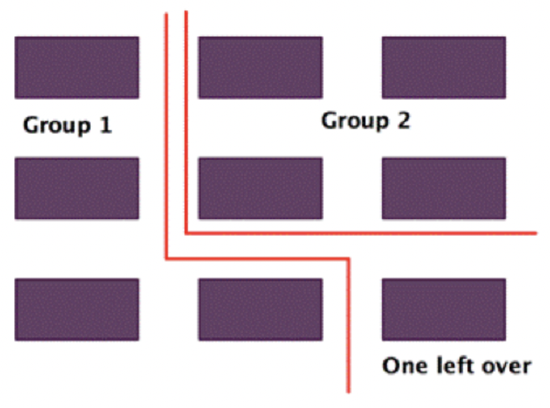
In mathematics, this left over part is called the remainder. It is the part that remains after performing the division. In the example above, the remainder is 1. We can write this as:
9÷2=4R1
We read this equation: “Nine divided by two equals four with a remainder of 1."
You might be thinking you could split that extra piece of chocolate in parts to share it. This is great thinking! If you split the chocolate in half, you could give each person another half of a piece of chocolate. They would each get 412 pieces of chocolate. We are not going to worry about expressing remainders as fractions or decimals right now. We are going to use the remainder notation with the letter R. Here’s an example:
45÷6
Solution
| 6⋅7=42 | How many sixes are there in 45? Try 7. |
| 45−42=3 | 3 is not enough for another 6. So, 3 is the remainder. |
45÷6=7R3
Since multiplication is the inverse of division, you can check your answer to a division problem with multiplication. To check the answer 7 R3, first multiply 6 by 7 and then add 3.
6⋅7=42
42+3=45, so the quotient 7 R3 is correct.
Compute 67÷7.
- 9
- 9 R4
- 60
- 10
- Answer
-
- Incorrect. 9⋅7=63. There is a remainder of 4. The correct answer is 9 R4.
- Correct. 9⋅7=63 and there are 4 left over.
- Incorrect. This is a division, not subtraction, problem. The correct answer is 9 R4.
- Incorrect. 70÷7=10, so the answer to 67÷7 cannot be; 9⋅7=63 and there are 4 left over. The correct answer is 9 R4.
Performing Long Division
Long division is a method that is helpful when you are performing division that you cannot do easily in your head, such as division involving larger numbers. Below is an example of a way to write out the division steps.
68÷4
Solution
| 4\longdiv68 | Rewrite the division. |
| 14\longdiv68−4 28 |
Divide the tens. What is 6 divided by 4? 4⋅1=4, so write a 1 above the 6. Subtract 4 from 6 and bring down the next digit of the dividend, 8. What is 28 divided by 4? |
| 174\longdiv68−4 28−280 |
7⋅4=28, so write a 7 above the 8. There is no remainder. |
|
\(\ \begin{array}{r} ^217 \\ |
Check your answer using multiplication. |
68÷4=17
6,707÷233
Solution
| 2233\longdiv6707−466 |
Examine the first 3 digits of the dividend and determine how many 233s are in it. Use guess and check. Try: 2⋅233=466 Try: 3⋅233=699 (too large) |
| 2233\longdiv6707−466 2047 | Subtract 466 from 670 and bring down the next digit of the dividend, 7. |
| 28233\longdiv6707−466 2047 −1864 183 |
How many 233s are in 2,047? It looks like close to 10 because 233⋅10=2,330. Try 9.233⋅9 equals 2,097. 22 233×92,097 2,097 (Too large) Must be 8! 22 233×81,864 |
|
233⋅28=6,524 6,524+183=6,707 |
Check your answer using multiplication. First, multiply 233⋅28. Then, add the remainder. |
6,707÷233=28R183
Compute 417÷34.
- 451
- 12
- 12 R9
- 13
- Answer
-
- Incorrect. This is a division problem, not an addition problem. The correct answer is 12 R9.
- Incorrect. 12⋅34=408. The correct answer is 12 R9.
- Correct. 12⋅34=408 and 408+9=417
- Incorrect. 13⋅34=442. The correct answer is 12 R9.
Dividing Whole Numbers by a Power of 10
Just as multiplication by powers of 10 results in a pattern, there is a pattern with division by powers of 10. Consider three quotients: 20÷10;200÷10;2,000÷10.
Think about 20÷10. There are 2 tens in twenty, so 20÷10=2. The computations for 200÷10 and 2,000÷10 are shown below.
200÷10
Solution
| 10\longdiv200 | Rewrite the problem. |
| 10\longdiv200 |
Divide the first digit of the dividend, 2, by the divisor. Since 2÷10 does not give a whole number, go to the next digit, 0. |
| 210\longdiv200 | 20÷10=2 |
| 210\longdiv200−20 0 |
2⋅10=20 20−20=0 |
| 210\longdiv200−20 00 | Bring down the next digit of the dividend, which is 0. |
| 2010\longdiv200−20 00 0 0 |
Since 10 still does not go into 00 and we have nothing left to bring down, multiply the 0 by 10. 0⋅10=0 0−0=0 We have no remainder. |
200÷10=20
2000÷10
Solution
| 10\longdiv2000 | Rewrite the problem. |
| 10\longdiv2000 |
Divide the first digit of the dividend, 2, by the divisor. Since 2÷10 does not give a whole number, go to the next digit, 0. |
| 210\longdiv2000 | 20÷10=2 |
| 210\longdiv2000−20 0 |
2⋅10=20 20−20=0 |
| 210\longdiv2000−20 00 | Bring down the next digit, 0, of the dividend. |
| 2010\longdiv2000−20 000 | Since 10 does not go into 00, add a 0 to the quotient and bring down the next digit, 0. |
| 20010\longdiv2000−20 00000 |
Since 10 still does not go into 000 and we have nothing left to bring down, add a 0 to the quotient, multiply the 0 by 10. 0⋅10=0 0−0=0 We have no remainder. |
2,000÷10=200
Examine the results of these three problems to try to determine a pattern in division by 10.
20÷10=2200÷10=202,000÷10=200
Notice that the number of zeros in the quotient decreases when a dividend is divided by 10: 20 becomes 2; 200 becomes 20 and 2,000 become 200. In each of the examples above, you can see that there is one fewer 0 in the quotient than there was in the dividend.
Continue another example of division by a power of 10.
2,000÷100
Solution
| 100\longdiv2000 | Rewrite the problem. |
| 100\longdiv2000 |
Divide the first digit of the dividend, 2, by the divisor. Since 2÷100 does not give a whole number, go to the next digit, 0. |
| 100\longdiv2000 |
Divide the first two digits of the dividend, 20, by the divisor. Since 20÷100 does not give a whole number, go to the next digit, 0. |
| 100\longdiv2000 | 200÷100=2 |
| 2100\longdiv2000−200 0 |
2⋅100=200 200−200=0 |
| 2100\longdiv2000−200 00 | Bring down the next digit, 0, of the dividend. |
| 20100\longdiv2000−200 0000 |
Since 100 still does not go into 00 and we have nothing left to bring down, add a 0 to the quotient, multiply the 0 by 10. 0⋅10=0 0−0=0 We have no remainder. |
2,000÷100=20
Consider this set of examples of division by powers of 10. What pattern do you see?
20÷10=2200÷10=202,000÷10=2002,000÷100=202,000÷1,000=2
Notice that when you divide a number by a power of 10, the quotient has fewer zeros. This is because division by a power of 10 has an effect on the place value. For example, when you perform the division 18,000÷100=180, the quotient, 180, has two fewer zeros than the dividend, 18,000. This is because the power of 10 divisor, 100, has two zeros.
Compute 135,000÷100.
- 13,500
- 134,900
- 13,500,000
- 1,350
- Answer
-
- Incorrect. This answer is too large. 13,500⋅100=1,350,000. The correct answer is 1,350.
- Incorrect. This is a division, not a subtraction, problem. The correct answer is 1,350.
- Incorrect. This is a division, not a multiplication, problem. The correct answer is 1,350.
- Correct. 1,350 \cdot 100=135,000.
Division by Zero
You know what it means to divide by 2 or divide by 10, but what does it mean to divide a quantity by 0? Is this even possible? Can you divide 0 by a number? Consider the two problems written below.
08 and 80
We can read the first expression, “zero divided by eight” and the second expression, “eight divided by zero.” Since multiplication is the inverse of division, we could rewrite these as multiplication problems.
0÷8=?
?⋅8=0
The quotient must be 0 because 0⋅8=0.
08=0
Now let’s consider 80.
8÷0=?
?⋅0=8
This is not possible. There is no number that you could multiply by zero and get eight. Any number multiplied by zero is always zero. There is no quotient for 80. There is no quotient for any number when it is divided by zero.
Division by zero is an operation for which you cannot find an answer, so it is not allowed. We say that division by 0 is undefined.
Using Division in Problem Solving
Division is used in solving many types of problems. Below are three examples from real life that use division in their solutions.
Luana made 40 empanadas for a party. If the empanadas are divided equally among 12 guests, how many will each guest have? Will there be any leftover empanadas?
Solution
| 40÷12 | Since each guest will have an equal share, we can use division. |
| 312\longdiv40−364 |
Use trial and error. Try 3. 12⋅3=36 When 40 empanadas are divided equally among 12 people, there are 4 left over. |
Each guest will have 3 empanadas. There will be 4 empanadas left over.
A case of floor tiles has 12 boxes in it. The case costs $384. How much does one box cost?
Solution
| 384÷12 | Since the boxes each cost the same amount, you want to divide $384 into 12 equal parts. |
| 12\longdiv384 |
Perform the division. Try to divide the first digit in the dividend by the divisor. 12 will not divide into 3, so go to the next digit. |
| 312\longdiv384−36 |
Perform 38÷12. Pick a quotient and test it. Try 3. 3⋅12=36. |
| 312\longdiv384−36 2 | Subtract 36 from 38. |
| 3212\longdiv384−36 24−240 |
Bring the next digit of the dividend down and perform division. 12⋅2=24 24−24=0 |
| 32×1264+320384 |
Does 32⋅12 equal 384? Check your answer by multiplying. Yes! The answer is correct! |
Each box of tiles costs $32
A banana grower is shipping 4,644 bananas. There are 86 crates, each containing the same number of bananas. How many bananas are in each crate?
Solution
| 4,644÷86 |
Since each crate, or box, has the same number of bananas, you can take the total number of bananas and divide by the number of crates. Rewrite the division. |
| 86\longdiv4644 |
Use trial and error to determine what 464÷86 equals. Try 5: 386×5430 |
| 586\longdiv4644−430 344 |
464−430=34 Then, bring down the next digit of the dividend, 4. |
| 5486\longdiv4644−430 344−3440 |
Use trial and error to determine the quotient of 344 and 86. Try 4: 286×4344 |
| 86×54344+43004644 |
Check your answer by multiplying. Yes! The answer is correct! |
Each crate contains 54 bananas.
A theater has 1,440 seats. The theater has 30 rows of seats. How many seats are in each row?
- 1,410
- 48
- 43,200
- 480
- Answer
-
- Incorrect. This answer is too large. Use division, 1440÷30, not subtraction for this problem. The correct answer is 48.
- Correct. 1440÷30=48.
- Incorrect. The answer is too large. Use division, 1440÷30, not multiplication, for this problem. The correct answer is 48.
- Incorrect. There is a place-value error. The correct answer is 48.
Summary
Division is the inverse operation of multiplication, and can be used to determine how to evenly share a quantity among a group. Division can be written in three different ways: using a fraction bar, using a division symbol, and using long division. Division can be represented as splitting a total quantity into sets of equal quantities, as skip subtracting on the number line, and as a dimension with an area model. Remainders may result when performing division and they can be represented with the letter R, followed by the number remaining. Since division is the inverse operation of multiplication, you need to know your multiplication facts in order to do division. For larger numbers, you can use long division to find the quotient.


